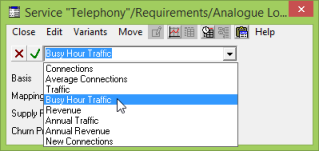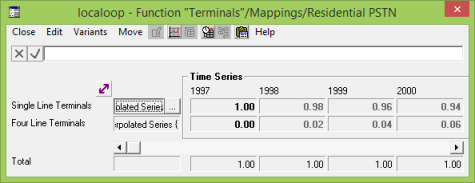The Service that a network offers is implemented by the Resources, optionally grouped by Function where several Resources all have a common role. Different Services may be carried over the same Resources and one Service may be carried by a number of different Functions and Resources.
Over time, there may be a change in the way that you will want to implement the Service over the network. You may want to add new Services that will access existing Resources or you may wish, at some point in the model run, to change over from one type of Resource to another in a common Function, reflecting advances in technology. Demand for one service may be on the decline and therefore Resources that were carrying that Service may become slack and available for another Service.
How incremental demand is met by the different types of Resource is defined in the Requirements dialog.
In our POTS model, we are not modelling a changeover but it is still necessary to indicate how the demand for telephony is satisfied by the Resources.
Defining the type of Resources required
 To indicate to STEM that a Service requires capacity from the Analogue Local Exchange Resource:
To indicate to STEM that a Service requires capacity from the Analogue Local Exchange Resource:
-
Click on the Connection button.
-
Click on the Telephony Service icon.
-
Click on the Analogue Local Exchange Resource icon.
-
 A green link appears between the two elements.
A green link appears between the two elements.
-
Double-click on this link to access the Requirements dialog, which indicates the Resources required to satisfy the demand for this Service. Alternatively, right-click on the link and select Details from the link context menu.
Note: You can also access this dialog from the Service icon menu.

Figure 1: The Requirements dialog
STEM provides seven options for the basis on which the network is dimensioned: Connections, Average Connections, Traffic, Busy Hour Traffic, Revenue, Annual Traffic, Annual Revenue and New Connections. In the POTS model the installation of new Resources to satisfy incremental demand is based on the Busy Hour Traffic.
Click on the arrow of the Basis pull-down list menu and select Busy Hour Traffic.

You will note that the Mapping input is already set to a constant 1.0. This was the effect of dragging to create the link between the elements, and indicates that the Resource is required by the Service throughout the model run. (Removing this link would be equivalent to setting this input to zero.)
If you group a number of Resources as a Function, indicating that each Resource plays a compatible role in the network, then you may choose to spread the incremental demand from a Service between these Resources, or to effect a change of technology over time. In this case, you will need to access the Mappings dialog for that Service and Function, which is most easily accessed by double-clicking the dark blue link which appears between the Service and the Function when the Service has a requirement for any one of the resources; alternatively, right-click on the Function and select Mappings from the dialog menu.
All of the types of Resource that you have created to fulfil a Function are listed in this dialog box and you define how you want the incremental demand for a service to be met through apportioning the demand across the available resources. In the localoop model, the Single Line Terminals and Four Line Terminals Resources are both in the Terminals Function, and the Residential PSTN Service initially requires only Single Line Terminals. Over time, a small proportion of new customers then demand Four Line Terminals. The proportions for the two Resources must always sum to 1.0.

Figure 2: The Mappings dialog
See 10.3.27 Resource requirements for more details.
If you have not saved your model recently, now would be a good time to do so.